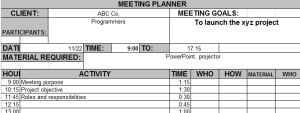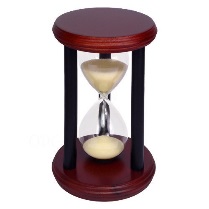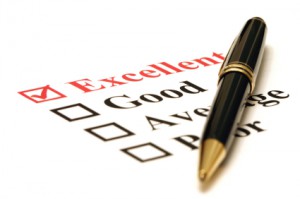Do people you work with complain that meetings are boring and unproductive? This is common in many organizations and for good reason. Many people running meetings have not been trained on meeting management and do not follow specific protocols.
Yet meetings are an important part of working on projects and making decisions. Following these protocols will make you an effective meeting manager.
Create an agenda
 An agenda should be created and sent out before the meeting to each participant. This will help people to prepare themselves and schedule their time. You can download the meeting agenda template on Excel that I use here.
An agenda should be created and sent out before the meeting to each participant. This will help people to prepare themselves and schedule their time. You can download the meeting agenda template on Excel that I use here.
Set meeting goals
Why is this meeting taking place? Explain the purpose or goal of the meeting as part of the agenda and at the beginning of the meeting.
Set a time limit
 The agenda should include the start and end time of the meeting. For whatever reason, if the decisions cannot be reached within the time frame allotted, schedule another meeting to complete the discussion.
The agenda should include the start and end time of the meeting. For whatever reason, if the decisions cannot be reached within the time frame allotted, schedule another meeting to complete the discussion.
Action steps
Take note of any decisions and action steps from the meeting discussion. Make sure that each action step is assigned to a person along with a due date. At the end of the meeting summarize the action steps and who is responsible along with the due date.
Meeting notes
Have the meeting notes typed up and sent to each participant. The meeting notes should be simple. They should state the decisions that were made, the actions required, by whom and by when. They should also indicate who was present or absent from the meeting. The date for the next meeting if any, should be included in the decisions.
Dealing with difficult people
 The hardest part of running an efficient meeting is dealing with personalities, especially the difficult ones. Remind people of the goals of the meeting and the time allotted so you can bring people back to the topic. You can also establish meeting norms that everyone agrees to follow and then remind people of these norms when things get off track. There are many articles about this on the web. Here is a good one.
The hardest part of running an efficient meeting is dealing with personalities, especially the difficult ones. Remind people of the goals of the meeting and the time allotted so you can bring people back to the topic. You can also establish meeting norms that everyone agrees to follow and then remind people of these norms when things get off track. There are many articles about this on the web. Here is a good one.
Assigning roles
The key roles for running an efficient meeting are chairperson, note taker and timekeeper. If you are the one that called the meeting you can assign people to the roles, which may alternate for each meeting.
Dealing with resistance to change
If you want to introduce these protocols for your meetings you may meet with resistance from some people. At the beginning of your next meeting you should simply state to the attendees that you want to improve meeting efficiency by applying these new protocols and you require everybody’s cooperation.
Meeting evaluation
 You can use this simple criteria to determine if your meetings are successful.
You can use this simple criteria to determine if your meetings are successful.
- Did the meeting start and end on time?
- Were the goals of the meeting met?
- How satisfied are the participants with how the meeting was run on a scale of 1 to 5?
By applying the above protocols you will turn your meetings into productive collaborative sessions that people will be glad to attend.
Stephen Goldberg